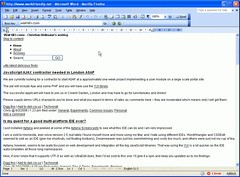I have this function I’ve used for quite a long time to shorten a string to a fixed amount of characters without breaking in between words:
function constrain(str,n){
var words = str.split(’ ‘);
var resultstr = ‘’;
for(var i = 0; i < words.length; i++ ){
if((resultstr + words[i] + ’ ‘).length>=n){
resultstr += ‘…’;
break;
}
resultstr += words[i] + ’ ‘;
}
return resultstr;
}
ately that it can get really slow with massive strings in Internet Explorer. This is a well-known issue and the solution is to
use arrays instead of concatenating strings.
This made me realise how convoluted the above example is and that it is much easier to do the same with an array:
function constrain(str,n){
if(str.length > n){
var s = str.substr(0, n);
var words = s.split(’ ‘);
words[words.length-1] = ‘’;
str = words.join(’ ‘) + ‘…’
}
return str;
}
You send a string and the amount of characters wanted as parameters and the function returns the string with the right lenght followed by a “...”.
Another way to work around the MSIE issue of slow concatenation is to use thea string builder.
